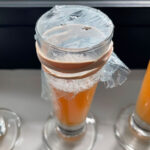Do Termites Fly In Your House? Yes, flying termites, also known as swarmers, can indeed find their way into your home, signaling a potential infestation. Flyermedia.net is committed to providing you with the information needed to identify these pests and protect your property. Understanding their behavior is crucial to effective termite control, ensuring the structural integrity of your home.
Table of Contents
1. Why Are Flying Termites in My House?
2. How to Identify Flying Termites?
3. What Attracts Termites to Homes?
4. The Dangers of Termite Infestation
5. Preventative Measures to Protect Your Home
6. Professional Termite Control Services
7. Types of Termites that Fly
8. Termite Swarming Season and What to Expect
9. Signs of Termite Damage
10. Addressing Termite Problems: A Step-by-Step Guide
1. Why Are Flying Termites in My House?
The main reason termites fly into your house is to establish new colonies. Termites that fly, also known as alates or swarmers, are the reproductive members of a termite colony. Their primary mission is to leave their original colony, find a mate, and start a new colony, potentially within or near your home.
 Flying Termite
Flying Termite
- Swarming Behavior: Termites typically swarm in large numbers during the spring and summer, particularly after rainfall when the conditions are humid and favorable.
- Attraction to Light: Swarmers are often attracted to light, which can lead them to enter homes through open windows, doors, or cracks in the foundation.
- Proximity to Existing Colonies: If you see swarmers inside your home, it’s a strong indication that a mature termite colony is nearby, possibly within the structure of your house.
According to research from the University of Florida, termite swarming is influenced by environmental factors such as temperature, humidity, and rainfall, making certain times of the year more conducive to termite activity.
2. How to Identify Flying Termites?
It is crucial to identify flying termites correctly to differentiate them from other flying insects, especially ants, which are often mistaken for termites.
- Straight Antennae: Termites have straight antennae, while ants have bent or elbowed antennae.
- Broad Waist: Termites have a broad waist, making their body appear uniformly thick, whereas ants have a narrow, pinched waist.
- Equal-Sized Wings: Termite swarmers have two pairs of wings that are equal in length, whereas ants have two pairs of wings of unequal length.
- Color: Flying termites are often dark brown or black.
 Flying Ant vs Termite
Flying Ant vs Termite
The presence of discarded wings near windowsills, doors, or other entry points is another telltale sign of termite activity. Swarmers shed their wings after finding a mate and a suitable location to start a new colony.
3. What Attracts Termites to Homes?
Understanding what attracts termites to your home can help you take preventative measures to make your property less appealing to these pests.
- Wood-to-Ground Contact: Termites can easily enter your home if wooden structures, such as decks or siding, are in direct contact with the soil.
- Moisture: Termites thrive in moist environments. Leaky pipes, poor drainage, and excessive humidity can attract termites to your home.
- Wood Piles: Storing firewood or other wood materials near your home provides termites with a readily available food source.
- Cracks and Gaps: Termites can enter your home through small cracks and gaps in the foundation, walls, and around pipes.
- Poor Ventilation: Inadequate ventilation in crawl spaces and attics can create a humid environment that attracts termites.
According to the USDA Forest Service, termites are attracted to cellulose, the main component of wood, and they can detect it from a distance.
4. The Dangers of Termite Infestation
Termite infestations can pose significant risks to your home and your financial well-being.
- Structural Damage: Termites feed on wood, which can compromise the structural integrity of your home. Over time, this can lead to costly repairs.
- Costly Repairs: The cost to repair termite damage can be substantial, often reaching thousands of dollars.
- Reduced Property Value: A termite infestation can reduce the value of your property, making it more difficult to sell.
- Hidden Damage: Termites often cause damage behind walls and under floors, making it difficult to detect until the problem becomes severe.
 Termite Damage
Termite Damage
According to the National Pest Management Association (NPMA), termites cause over $5 billion in property damage each year in the United States.
5. Preventative Measures to Protect Your Home
Taking proactive steps can significantly reduce the risk of termite infestation.
- Eliminate Wood-to-Ground Contact: Ensure that wooden structures are not in direct contact with the soil. Use concrete or metal barriers to create a physical barrier.
- Manage Moisture: Repair leaky pipes, improve drainage, and ensure proper ventilation in crawl spaces and attics to reduce moisture levels.
- Store Firewood Properly: Store firewood away from your home and off the ground.
- Seal Cracks and Gaps: Seal cracks and gaps in your foundation, walls, and around pipes to prevent termites from entering your home.
- Regular Inspections: Schedule regular termite inspections by a qualified pest control professional.
6. Professional Termite Control Services
If you suspect a termite infestation, it’s essential to seek professional help. Pest control services can offer effective solutions to eliminate termites and prevent future infestations.
- Inspection: A thorough inspection by a trained technician to identify the extent of the infestation and the species of termites involved.
- Treatment Options: Various treatment options, including liquid termiticides, baiting systems, and fumigation, depending on the severity of the infestation.
- Preventative Treatments: Preventative treatments to protect your home from future termite infestations.
- Ongoing Monitoring: Regular monitoring to ensure that termites do not return.
Flyermedia.net recommends contacting a certified pest control company with experience in termite control to ensure the job is done effectively.
7. Types of Termites that Fly
Several types of termites can fly, each with distinct characteristics and behaviors.
- Subterranean Termites: These are the most common type of termites in the United States. They live in the soil and build mud tubes to reach food sources.
- Drywood Termites: Drywood termites do not require contact with the soil. They infest dry wood, such as furniture and structural timber.
- Dampwood Termites: Dampwood termites are attracted to moist wood. They are often found in decaying logs and damp areas around homes.
- Formosan Termites: These are an aggressive species of subterranean termites that can cause extensive damage in a short period.
According to a study by Texas A&M University, Formosan termites are particularly destructive due to their large colony sizes and rapid reproduction rates.
8. Termite Swarming Season and What to Expect
Termite swarming season typically occurs in the spring and summer, but it can vary depending on the species and geographic location.
- Spring Swarming: Subterranean termites often swarm in the spring, usually after a rainfall.
- Summer Swarming: Drywood termites typically swarm in the summer months.
- Environmental Factors: Warm temperatures and high humidity can trigger termite swarming.
- What to Expect: During swarming season, you may notice large numbers of flying termites near your home. This is a sign that a mature colony is nearby and potentially infesting your property.
 Termite Swarming
Termite Swarming
9. Signs of Termite Damage
Recognizing the signs of termite damage can help you detect an infestation early and prevent extensive damage.
- Mud Tubes: Mud tubes are pencil-sized tunnels that termites build to travel between their colony and food sources.
- Hollow Sounding Wood: Wood that sounds hollow when tapped may be damaged by termites.
- Sagging Floors or Ceilings: Termite damage can cause floors and ceilings to sag.
- Loose or Damaged Wood: Wood that is easily broken or damaged may be infested with termites.
- Frass: Frass is termite droppings, which look like small, dark pellets.
10. Addressing Termite Problems: A Step-by-Step Guide
If you suspect a termite infestation, follow these steps to address the problem effectively.
- Identify the Termites: Determine if the insects you see are termites and what type they are.
- Inspect Your Property: Look for signs of termite damage, such as mud tubes, hollow-sounding wood, and frass.
- Contact a Professional: Hire a qualified pest control company to conduct a thorough inspection and recommend treatment options.
- Implement Treatment: Follow the pest control company’s recommendations for treatment, which may include liquid termiticides, baiting systems, or fumigation.
- Prevent Future Infestations: Take preventative measures to protect your home from future termite infestations, such as eliminating wood-to-ground contact and managing moisture.
- Regular Monitoring: Schedule regular termite inspections to ensure that termites do not return.
By following these steps, you can effectively address termite problems and protect your home from costly damage.
Don’t let termites compromise the safety and value of your home. At Flyermedia.net, we understand the importance of protecting your investment. If you’re in the Daytona Beach, FL area and suspect termite activity, contact us at +1 (386) 226-6000 or visit our website at flyermedia.net for a free termite inspection. Our team of experienced professionals is ready to provide you with effective termite control solutions to safeguard your home.

